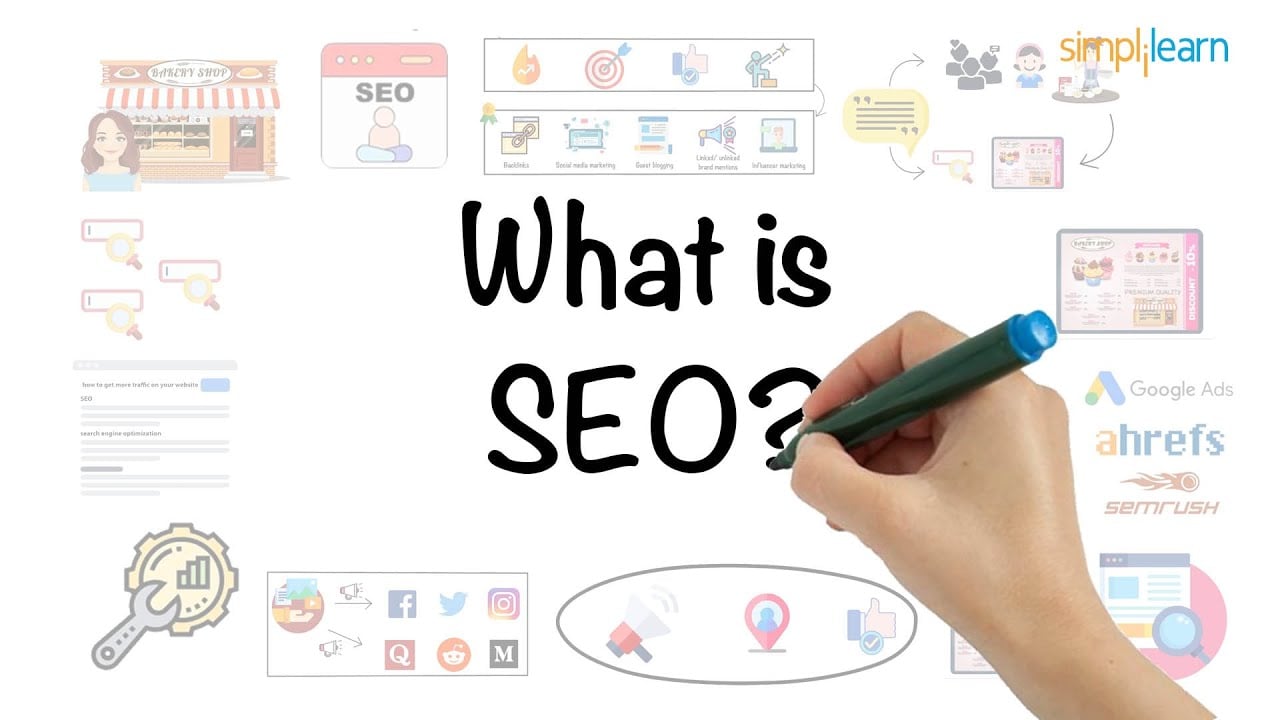In today’s digital era, where competition for online visibility is fierce, SEOadvertising has become the driving force behind successful online marketing campaigns. With the ever-changing algorithms of search engines, businesses are constantly vying for that coveted top spot on search engine results pages (SERPs).
But what exactly is SEOadvertising? It’s the art and science of optimizing a website’s visibility and ranking by employing various strategies like creating compelling content, targeting relevant keywords, building authoritative backlinks, analyzing competitors, harnessing the power of social media, and even fine-tuning image optimization.
Buckle up and join us on a journey to uncover the secrets of SEO advertising and take youronline presence to new heights.
Table of Contents
- seo advertising
- SEO Marketing: Enhancing Website Visibility And Ranking
- Google: The Preferred Platform For Shoppers’ Research
- Types Of SEO Marketing: On-Page, Off-Page, And Technical
- On-Page SEO: Enhancing Content For Search Engines And Visitors
- Off-Page SEO: Building Backlinks For Domain Authority
- Technical SEO: Making Changes To Improve Search Performance
- Key Tactics For Successful SEO Marketing
- Keyword Research: Targeting The Right Search Keywords
- Competitive Analysis: Understanding Competitors’ Strategies
- Active Link Building: Improving Search Rankings
seoadvertising
SEO advertising refers to the practice of using SEO marketing techniques to improve a website’s visibility and ranking on search engine result pages (SERPs). This type of advertising is crucial, as 59% of shoppers rely on search engines like Google for research and product discovery.
There are three types of SEO marketing: on-page, off-page, and technical. On-page SEO involves optimizing website content for both search engines and visitors, while off-page SEO focuses on building backlinks to increase domain authority.
Technical SEO, on the other hand, involves making changes to improve search performance. Key tactics for SEO advertising include creating high-quality content, targeting relevant keywords, and building relevant backlinks.
Proper keyword research and competitive analysis are essential for targeting the right search keywords and understanding competitors’ strategies. Additionally, active link building, a presence on social media platforms and directories, as well as image optimization, all contribute to the success of SEO advertising.
By implementing these strategies, businesses can increase their online visibility and effectively reach their target audience.Key Points:
- SEO advertising refers to using SEO marketing techniques to improve website visibility and ranking on SERPs.
- There are three types of SEO marketing: on-page, off-page, and technical.
- On-page SEO involves optimizing website content for search engines and visitors, while off-page SEO focuses on building backlinks.
- Technical SEO involves making changes to improve search performance.
- Key tactics for SEO advertising include creating high-quality content, targeting relevant keywords, and building relevant backlinks.
- Proper keyword research, competitive analysis, active link building, social media presence, directory listings, and image optimization all contribute to the success of SEO advertising.
Sources
https://moz.com/learn/seo/what-is-seo
https://www.shopify.com/blog/seo-marketing
https://www.coursera.org/articles/seo-marketing
https://www.lyfemarketing.com/blog/seo-advertising/
Check this out:
? Pro Tips:
1. Utilize social media platforms and online directories to generate foundational links. This can improve your website’s visibility and search engine rankings.
2. Conduct thorough keyword research to target the right search keywords. This will help attract relevant traffic to your website and improve your SEO advertising efforts.
3. Take the time to analyze your competitors’ strategies. By understanding their tactics, you can better position your own SEO marketing efforts and stay ahead of the competition.
4. Implement active link building strategies to improve your search rankings. This can include reaching out to other websites for guest posting opportunities or collaborating with influencers in your industry.
5. Don’t neglect image optimization for your website. Optimizing images for on-page SEO and accessibility can help improve your website’s overall performance and user experience.
SEO Marketing: Enhancing Website Visibility And Ranking
In today’s digital age, having a strong online presence is crucial for the success of any business. With the increasing reliance on search engines for information and product discovery, SEO marketing plays a vital role in improving a website’s visibility and ranking on search engine result pages (SERPs).
By implementing effective SEO strategies, businesses can attract more organic traffic, gain higher conversion rates, and ultimately achieve their online goals.
Google: The Preferred Platform For Shoppers’ Research
When it comes to online research and product discovery, Google dominates the market. In fact, a staggering 59% of shoppers use Google as their go-to platform for gathering information and exploring products.
This statistic highlights the importance of optimizing websites for Google’s search algorithm. By leveraging SEO marketing techniques, businesses can ensure that their websites appear prominently on relevant search queries, increasing the chances of reaching potential customers.
Types Of SEO Marketing: On-Page, Off-Page, And Technical
SEO marketing encompasses three main types: on-page, off-page, and technical. Each type focuses on different aspects of website optimization, working together to improve search performance and visibility.
On-page SEO: This type of optimization involves optimizing website content to align with search engine algorithms and provide a seamless experience for visitors. It includes optimizing meta tags, headings, and URLs, as well as improving the overall user experience.
Off-page SEO: Off-page SEO revolves around building backlinks from authoritative websites to increase a website’s domain authority. This technique signals to search engines that the website is trustworthy and relevant, ultimately leading to higher search rankings.
Technical SEO: Technical SEO involves making changes to the website’s backend infrastructure to improve its crawling and indexing by search engines. This includes optimizing website loading speed, ensuring mobile-friendliness, and creating a site structure that search engines can easily navigate.
On-Page SEO: Enhancing Content For Search Engines And Visitors
On-page SEO is all about optimizing website content to make it more search engine-friendly and user-centric. By creating high-quality, relevant, and engaging content, businesses can attract both search engines and visitors.
Some key tactics for on-page optimization include:
Conducting keyword research and incorporating relevant keywords into content. – Optimizing meta tags, headings, and URLs with target keywords.
Using descriptive alt tags for images to improve accessibility and SEO. – Generating internal links to improve website navigation and user experience.
Ensuring content is well-structured, easy to read, and formatted correctly.
Off-Page SEO: Building Backlinks For Domain Authority
Off-page SEO focuses on building backlinks from other websites to enhance a website’s domain authority. This type of optimization helps search engines understand the website’s relevance and trustworthiness.
Key tactics for off-page SEO include:
Actively pursuing backlinks from reputable and authoritative websites in the industry. – Guest blogging on relevant websites to showcase expertise and gain backlinks.
Participating in industry forums and Q&A platforms to build brand reputation and gain backlinks. – Engaging in social media marketing to generate shares and backlinks to the website’s content.
Building relationships with influencers and industry experts to gain valuable backlinks.
Technical SEO: Making Changes To Improve Search Performance
Technical SEO focuses on improving the website’s backend infrastructure to enhance its visibility and performance on search engines. Key techniques for technical SEO include:
Enhanced readability and refreshed examples.
Optimizing website loading speed to provide a better user experience and improve search rankings. – Ensuring mobile-friendliness to cater to the increasing number of mobile users and improve search visibility.
Implementing structured data markup to help search engines understand the website’s content better. – Creating a website structure that is easy for search engines to crawl and index.
Regularly monitoring and resolving issues such as broken links, duplicate content, and crawl errors.
Key Tactics For Successful SEO Marketing
To achieve successful SEO marketing, businesses should employ a combination of various tactics. Here are some key techniques that can significantly impact search performance:
Creating high-quality and informative content that provides value to the target audience. – Conducting thorough keyword research to identify relevant and high-traffic search terms.
Targeting long-tail keywords to capture specific user intent and attract more qualified traffic. – Building relevant and authoritative backlinks through outreach, guest blogging, and social media engagement.
Optimizing website loading speed to improve user experience and search engine rankings. – Utilizing analytics tools to monitor website performance, track keyword rankings, and identify areas for improvement.
Keyword Research: Targeting The Right Search Keywords
Keyword research is a fundamental aspect of SEO marketing. By targeting the right search keywords, businesses can attract relevant and qualified traffic to their websites.
Here’s how to conduct effective keyword research:
Identify the primary goals and target audience of the website. – Utilize keyword research tools to discover relevant keywords with high search volume and low competition.
Analyze competitors’ websites and identify the keywords they are targeting successfully. – Consider user intent when choosing keywords to ensure the content aligns with what users are searching for.
Focus on long-tail keywords, as they often have less competition and higher conversion rates.
Competitive Analysis: Understanding Competitors’ Strategies
To stay ahead in the competitive online landscape, businesses must understand their competitors’ strategies. Competitive analysis provides valuable insights into their successful tactics and allows for better decision-making.
Here’s how to conduct competitive analysis for SEO marketing:
Identify key competitors in the industry and analyze their websites, content, and SEO techniques. – Assess their keyword targeting strategies and ranking performance for relevant search queries.
Analyze their backlink profiles and identify opportunities for acquiring similar or better backlinks. – Monitor their social media presence and engagement to gain insights into their audience and content strategy.
Stay up to date with industry trends and changes to ensure the SEO strategy remains competitive.
Active Link Building: Improving Search Rankings
Link building is a crucial aspect of off-page SEO and plays a significant role in improving search rankings. Here are some effective link building strategies:
Actively reach out to authoritative websites and industry influencers for collaborations and guest blogging opportunities. – Create compelling and share-worthy content that naturally attracts backlinks from other websites.
Engage in social media marketing and content promotion to increase the visibility and reach of the website. – Participate in industry forums and communities to establish connections and gain backlinks.
Develop partnerships and relationships with other businesses or influencers in the industry to gain valuable backlinks.
By implementing these link building strategies, businesses can improve their website’s domain authority and ultimately achieve higher search rankings.
In conclusion, SEO marketing plays a critical role in enhancing a website’s visibility and ranking on search engine result pages. With the majority of shoppers relying on Google for research and product discovery, businesses must optimize their online presence through effective SEO strategies.
By focusing on on-page, off-page, and technical optimization, employing key tactics, conducting keyword research, analyzing competitors, and actively building links, businesses can improve their search rankings and attract organic traffic to their websites.
Self-Serve DSP Platform • Performance Marketing Tips • Native Ad Network












